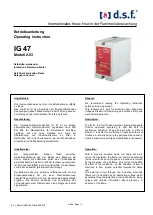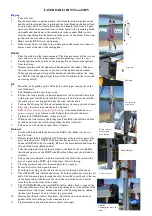
2
009371_p_--_--
en
Installation
Intended use
The manual call points FDM225-xx and FDM226-xx are
for manual alarm activation in the event of a fire.
The manual call point FDM225-xx (Fig. 1) consists of a
housing cover (1) and a switching unit (2).
The back boxes FDMH295-R and FDMH295-S are
available as an option for surface mounting.
The manual call point FDM226-xx (Fig. 2) consists of a
housing cover (1), a switching unit (2), and a back box (3).
A protective cover FDMC295 (accessories) can be
installed for both manual call points to prevent
unintentional alarm activation.
Secure the manual call points at a height of 0.9…1.6 m on
an even surface.
Observe the country-specific regulations for the
exact installation height!
Preparation and installation
FDM225:
1.
Insert the key (4) into the manual call point from below
and pull the housing cover (1) forward and away from
the switching unit (2) (as in Fig. 3).
If you are using back box FDMH295-R, the following
additional measures are necessary:
2.
Determine the positions of the entry openings in the
back box.
3.
Mark the drill hole(s) with Ø max. 20 mm on the back
box according to the drilling jig (Fig. 5).
4.
Clamp the back box in a bench vice.
CAUTION
Improper use of tools
Danger of injury
Observe the tool manufacturer's safety notices.
5.
Drill the entry opening(s) (Fig. 6).
FDM226:
1.
Insert the key (4) into the manual call point from below
and pull the housing cover (1) forward and away from
the switching unit (2) (Fig. 3).
There are openings available at the top and bottom of the
back box (3) for installing cable glands M20 x 1.5 with
counter nuts (accessories).
2.
Break out the required entry openings in the back
box (3).
3.
Install the required cable glands.
4.
Cut out the side openings for both fastening tabs (5) on
the rear side of the back box (see Fig. 4).
5.
Install the fastening (5) tabs from behind onto the rear
wall of the back box (3) using the screws supplied.
6.
Install the back box (3) on a level surface using the
fastening tabs (5).
The FDM226 must be installed using the fastening
tabs. Do not drill any holes in the rear wall of the
back box, and make sure to install the back box
and switching unit correctly so that the specified IP
protection category is ensured.
Connecting the switching unit to the electricity
1.
If the detector line cables are shielded (Fig. 7), connect
the shielding to a connection terminal DBZ1190-AB
(accessories). The shielding must not touch any other
potentials or metal parts in the device.
2.
Connect the detector line (Fig. 7).
Note the positive and negative poles.
Only connect one wire per terminal. This is the
only way to ensure the connection is failure-free
for the entire service life of the device.
3.
Install the switching unit (2) in a recessed box
(FDM225) or in the back box (3). Pay attention to the
feed line when inserting the switching unit (2) into a
recessed box or the back box. Avoid crushing the feed
line.
4.
Install the housing cover (1) on the switching unit (2).
Installation of protective cover FDMC295
·
Engage the protective cover in the two recesses in the
housing cover (see Fig. 9).
Testing
1.
Insert the key (4) in the detector so that the insert
moves (Fig. 8).
è
The detector is triggered.
2.
To arm the manual call point, pull out the key again.
è
The insert is straight and the manual call point has
been set.
WARNING
Deactivating the manual call points prevents
alarms from being forwarded
The alarm is not triggered.
Label deactivated or inoperable manual call points
as "NOT IN USE".
You will find more information in
document 009757.


























